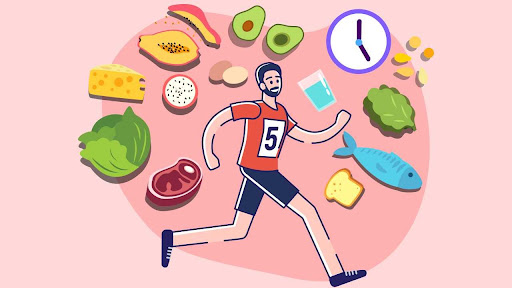
How to Avoid Losing Weight While Marathon Training

Now this can seem counterintuitive to most of us, but some marathon runners are eager to not lose weight while performing regular, long-duration, and intense cardiorespiratory exercises. They are not in favor of marathon training and weight loss at the same time. Of course, they are burning many calories as they train and compete, resulting in a calorie deficit while marathon training. So, consuming enough food to fuel that effort while maintaining their body weight can be a challenge. The underlying concern is about maintaining muscle mass.
Many runners, particularly newcomers, have likely been told that it is nearly impossible to avoid losing muscle mass when they train for marathons. However, there are ways to avert that fate. The two factors that marathoners can utilize to simultaneously excel in their running performance and maintain muscle mass are nutrition and exercise.
Nutrition
It is vital to eat enough high-quality calories to fuel the amount of exercise you are performing. This becomes more important if you are introducing resistance training to your workout regime. The best diet for half marathon training includes nutrient-dense and healthy foods. Adhere to your usual carbohydrate-loading protocol as the event date gets nearer.
Here are a few tips for adding calories to your diet in a nutritious way:
1. Analyze what you are consuming during every meal
Typically, runners eat at frequent intervals throughout the day to meet their energy needs. So, adding more snacks or meals to your schedule is impractical. Instead, think about how you can add healthy protein or carbohydrates to your daily meals.
For example, to increase your protein intake, you can add lean meats to salads, protein powder to cereal or oatmeal, or include cheese when snacking on whole fruits. If you wish to add more healthy carbohydrates to your meals, then consider including whole-grain crackers to fruits, a third slice of bread in the middle of a sandwich, and oats and whole fruits to yogurt-based snacks.
Also, replace low-calorie, low-nutrient foods like granola bars or white bread with calorie-rich and nutrient-dense choices like meal-replacement shakes and whole-grain bread. Including some of these best foods for marathon training can benefit you immensely.
2. Drink your calories
Another way to add calories without feeling like you are eating throughout the day is through liquids. Smoothies, juices that comprise 100% fruits or vegetables, and protein shakes can help you consume calories without making unhealthy choices.
Also Read: How to Fuel for Long-distance Runs
Exercise
Distance running undoubtedly builds some muscle. Most endurance athletes end up building lean and muscular calves and quadriceps. That said, running is unlikely to contribute to the development of larger muscles, also known as muscle hypertrophy.
However, if you want to maintain your muscle mass while training for marathons, the first step is to build additional muscle before you start completing longer training runs. This requires adding muscle-strengthening activities to your regimen. To be more specific, hypertrophy-focused training requires that you perform strength training exercises targeting all major muscle groups while adhering to guidelines, such as:
| Sets | Repetitions | Rest Interval | Intensity |
| 3–6 | 6–12 | 30–90 seconds | 67%–85% of one-repetition maximum |
The first three columns of that table are self-explanatory, but determining the appropriate intensity for your resistance training can be difficult. Finding the right resistance is essential. However, do note that lifting extremely light weights will not give you the desired results. Conversely, lifting very heavy weights may raise the risk of injury. To understand your one repetition max read till the end.
Also Read: How to Train Safely and Avoid Injuries at Home
Your one-repetition maximum (1-RM) is the amount of resistance you can move through a full range of motion once, when performing a particular exercise before the muscles are temporarily fatigued.
Fortunately, you do not need to max out on each exercise to determine your 1-RM. Instead, you can use a method for estimating your 1-RM based on the number of repetitions completed with a given load
If you can lift a weight with good form for six repetitions but not seven, it means you are lifting approximately 85% of your 1-RM. Similarly, if you are able to perform a maximum of 12 repetitions, then you are lifting about 67% of your 1-RM. This is a fairly broad range. So, a good strategy is to find a weight for each exercise with which you can perform six (but not seven) repetitions before fatiguing. Then, continue using that weight until you have performed 12 repetitions. Later, increase the weight by 5%. By doing this, you may feel tired more quickly. Finally, exercise with that new weight until you can perform 12 repetitions. Repeat this process.
For instance, you perform the bench press exercise with 60kg weights and can complete six repetitions in each set. Continue to lift 60kg until you can perform 12 repetitions in each set by maintaining a good form. Then, increase the weight by 5%. So, now you are lifting 63kg. Although this is not a huge jump, it will probably mean that you can perform fewer repetitions per set. You can then workout with this weight until you again reach 12 repetitions per set. Later, increase the resistance by another 5%, to 66kg.
Using this strategy to design a full-body resistance-training program will enable you to build muscle mass. If you need more convincing, strength training can make you faster and less injury-prone due to improvements in the core, lower-body, and upper-body.
Maintaining energy balance is a dynamic process. It changes with your exercise level and intensity, body composition, activities of daily living, hormonal control of appetite, and myriad other factors. Therefore, it is necessary to self-monitor while making dietary and exercise changes to see how these modifications are impacting your body weight and composition.
References
1. American College of Sports Medicine. ACSM’s Guidelines for Exercise Testing and Prescription (11th edition). Philadelphia: Wolters Kluwer, 2022.
2. American Council on Exercise. The Exercise Professional’s Guide to Personal Training. San Diego: American Council on Exercise, 2020.
3. Sheppard JM, Triplett NT. Program Design for Resistance Training. In: Haff GG, Triplett NT, eds. Essentials of Strength Training and Conditioning (4th edition). Champaign, Ill.: Human Kinetics, 452.
4. Vitale K, Getzin A. Nutrition and supplement update for the endurance athlete: Review and recommendations. Nutrients 2019, 11, 6: 1289.














